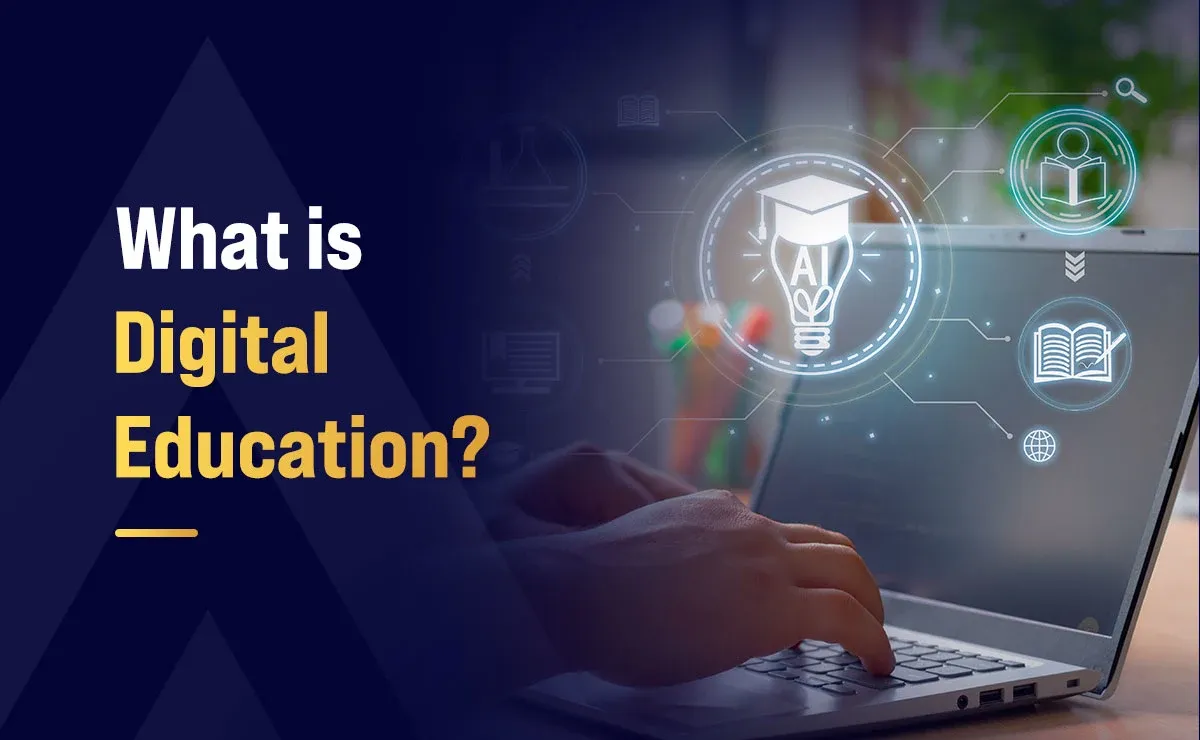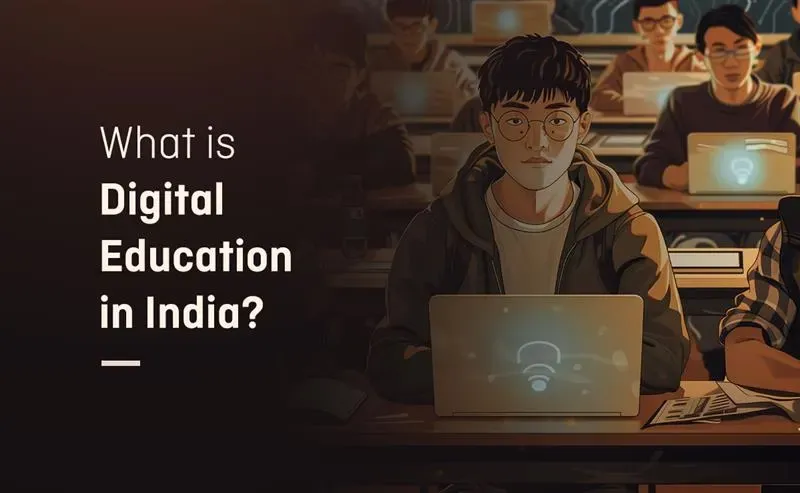What is Digital Education?

The educational environment is changing due to rapid technological advances and emerging skills. Although traditional classroom-based learning remains valuable, the possibilities of digital education solutions that offer unprecedented flexibility, accessibility, and personalization complement it.
Some would even argue that the traditional education system should be completely replaced by modern teaching methods that equip students with knowledge and skills for new-age roles and responsibilities, creating accessible, high-growth opportunities for millions of students.
Additionally, the student’s demand for digital-first opportunities is fundamentally changing how education is delivered and acquired in the 21st century. Beyond responding to modern needs, let's understand the importance of digital education in India.
Digital education uses technology to make learning easier, more engaging, and relevant to today’s job market. At Altera Institute, our PGP in Marketing reflects this approach by using digital tools, hands-on projects, and personalized mentorship. If you're curious about how digital learning can boost your career, our Marketing PGP program is a great example to explore.
What is Digital Education in India?

Simply put, digital education involves the application of digital tools/resources to support teaching and learning. It gives students access to a wide range of opportunities, resources, and tools that traditional classroom-based approaches often do not.
It combines modern technology with instructional methods to make the environment lively and interactive, making the experience memorable for both teachers and learners. To illustrate, digital tools allow students to access course content once again, monitor their learning processes, and identify areas for improvement.
Schools and institutions are increasingly integrating digital education to offer flexibility, affordability, and a customised learning experience, to ensure its applicability in the contemporary world.
Regarding issues like the digital divide and data security, digital education will continue to change lives, and learning will become an experience that everybody can access and will be greatly improved in the process.

Advantages of the Digital Education System
With the advent of the digital education system, a plethora of benefits has become available to satisfy various learning styles, increase accessibility and enhance the overall quality of education. The following are the main advantages that make digital education a groundbreaking solution for students:
1. Personalized Learning Experience:
Classroom learning is based on the traditional one-size-fits-all approach, in which some students need more time to fit in with the rest, whereas others might feel challenged. Digital platforms, on the other hand, facilitate individualized learning experiences, allowing students to learn at their own pace.
You can review a topic again or accelerate your pace, and the system is flexible, letting you learn in the way that works best for you, enabling you to achieve better results and develop a deeper understanding of the learning content.
2. Access to Unlimited Resources:
There is unlimited knowledge available on the internet, and digital education makes this vast knowledge readily accessible to students. Students have an opportunity to go beyond classroom learning and to study what interests them personally.
This free access to various educational resources expands their horizons and provides an opportunity for self-directed learning and exploration, enhancing the learning process.
3. Flexibility and Convenience:
Digital education overcomes the barriers of time and place. Students are no longer required to be in a classroom in order to get a quality education. Online courses and learning platforms make education accessible with a single click, whether you are at home, in a coffee shop, or even while traveling.
Digital learning offers great flexibility, which is why students can juggle their studies with other life responsibilities, such as employment or extracurricular activities, thereby increasing access to education for diverse learners.
4. Real-Time Feedback:
Online education provides feedback immediately. It can be automated in quizzes, assignments, or performance analytics, and students receive timely feedback on their progress. Real-time feedback can highlight strengths and weaknesses so students can take the necessary action in time to improve.
Moreover, digital systems track progress and performance and hold students accountable for their learning, making them more proactive and self-motivated.
5. Preparation for the Future Job Market:
Digital education enables students to acquire skills in data analysis, digital marketing, eCommerce, and AI-supported decisions as industries are becoming more dependent on digital skills. These competencies are highly sought after in the workforce, and digital learning enables students to acquire practical skills in these areas and come out job-ready from Day 1.
As more companies go digital, digitally fluent graduates are more likely to succeed in new jobs and sectors.
Technologies for Digital Education
The swift advancement and implementation of state-of-the-art technological solutions propels the evolution of digital education. Not only do these new digital tools change how students learn, but they also make learning personalized, pervasive and interactive.
We will explore the revolutionary technologies redefining digital learning and the immense potential they offer for learners.
1. Learning Management Systems (LMS):

LMS is an overall digital platform that systematizes, delivers, and handles learning materials and resources. Platforms like Google Classroom enable students to access course materials, track their progress, complete assignments, and engage in discussions—all from one location.
For students, an LMS implies convenience; everything they require in their courses can be accessed at the tap of a button, and they will have the freedom to learn at their own speed.
2. Virtual Classrooms and Web Conference Systems:
The main component of the digital education ecosystem is virtual classrooms, which enable both students and instructors to attend real-time learning sessions. Zoom, Microsoft Teams, and Google Meet are popular video conferencing solutions used to deliver real-time lectures, discussions, and tutorials.
These platforms allow students to feel connected and interact with their instructors and peers, which builds collaboration, participation, and a more interactive learning experience.
3. Gamification and Interactive Learning Tools:
Gamification in education introduces competitive features such as achievement badges, scoring, and levels of progression in learning tasks. Examples of educational platforms that implement gaming mechanics to increase student motivation and retention of the information include Duolingo.
Gamification helps motivate users, encourage healthy competition, and reinforce key ideas by turning the learning process into a fun, interactive game. These tools replicate real-life settings and promote understanding and problem-solving skills.
4. Artificial Intelligence (AI) and Machine Learning:
Digital education is being revolutionized by artificial intelligence and machine learning, enabling a unique learning experience for every student. These technologies can be used to study the behavior of students, identify their learning gaps, and suggest resources specific to them to learn better.
AI-powered chatbots, like those used in platforms such as Duolingo, can offer instant assistance to students, answering queries and guiding them through lessons. For students, AI-driven tools create a more individualized learning journey to maximize their potential.
Digital Revolution and Its Effects on Education
The digital revolution has transformed education, making it more accessible, personalised and engaging for students. Digital tools have made learning not a classroom-based endeavour, as students can gain access to learning resources at any time, anywhere, providing flexibility and freedom.
Personalized education tools use AI to tailor educational materials to learners, increasing desired retention and participation. Teamwork and multifaceted perspectives are also promoted as students around the world connect through collaborative tools. Gamification and other interactive technologies can make lessons more dynamic and enhance the learning process and interest.
Digital education is a solution to the disconnect between traditional education and industry's demands, as it equips students with the practical skills needed in a technology-driven world. The industry today needs more talent skilled in domains such as eCommerce, Product, Growth, Brand, Strategy, Media, and more. These roles require specialised skills best learned through practical application, facilitated by digital education.
It also focuses on lifelong learning, which helps students adapt to changing careers. With the use of digital tools, students learn the skills and knowledge needed to succeed in a rapidly changing, globalized world.
Difficulties in Implementing Digital Education
1. Limited Digital Infrastructure:
One of the most significant obstacles to the digitisation of learning is poor infrastructure. Many students, particularly those from rural and disadvantaged backgrounds, do not have access to internet connectivity, modern devices, or electricity. This digital divide fails to provide equal access to learning opportunities, leaving a large portion of the population at a disadvantage.
2. High Cost of Technology:
Many people find that purchasing digital tools such as laptops, tablets, and software subscriptions is too costly. Even institutions face difficulties in implementing modern technologies due to funding constraints. The cost is another obstacle that often prevents digital education from being adopted on a large scale.
3. Lack of Trained Teachers:
In order to ensure that digital education is effective, teachers should have sufficient knowledge about technology and how to effectively incorporate it into their lesson plans. Nevertheless, the success of digital learning programs is hindered by the fact that most educators lack the training and tools to transition from traditional to tech-driven classrooms.
4. Resistance to Change:
The shift towards conventional ways of education to digital platforms is frequently faced with opposition on the part of teachers and learners. Students who are not accustomed to digital tools can find it hard to use new technologies, whereas teachers who are accustomed to traditional teaching methods might be unwilling to accept change. Hence, it is important to establish trust and tolerance amongst the stakeholders to ensure successful implementation.
5. Cybersecurity and Privacy Concerns:
In the context of the emergence of digital education, the issue of data privacy and cybersecurity has gained greater significance. Schools, students, and parents are concerned about the misuse of personal information, unauthorized access, and the dangers posed by online platforms. Hence, securing systems and sensitive information is an important challenge here.
6. Content Relevance and Localization:
Even though online sources provide vast amounts of information, a significant part of the content might not correspond to the local curricula or cultural specifics. Therefore, it is also a significant challenge to make digital educational content relevant, engaging, and specific to different educational needs.
7. Uneven Engagement Levels:
The nature of digital education is self-directed, which creates dissimilar levels of engagement among students. Some students would perform well in a technology-based environment, and others would not be able to be motivated in the same way without the traditional classroom and socializing amongst their peers. It is therefore necessary to come up with measures that will guarantee the frequent involvement of different learner profiles.
8. Technical Difficulties and Accessibility:
The learning process may be interrupted by technical problems, like software glitches, malfunctions, or crashes of the platform. Also, facilities that are accessible to students with disabilities are not given much consideration, posing challenges in inclusive learning.
9. Overemphasis on Screen Time:
Overuse of digital tools will result in spending more hours on screens, which will potentially harm the health of students, such as eye problems, lack of exercise, and mental exhaustion. This is why it is necessary to balance both digital and offline activities to achieve holistic development.
What is the Functionality of Digital Learning?
Digital learning thrives because it embraces technological advancements to provide personalized, flexible, and interactive learning. By analysing student performance using advanced data analysis, these platforms develop personalized learning pathways.
This is a focused method that will help students focus on areas that need improvement and strengthen their existing knowledge base. Interactive applications, such as videos, quizzes, and gamified modules, make the learning process more engaging and help simplify complex ideas.
Excellent access to digital learning is also one of its strengths. All educational facilities and previously recorded lectures can be accessed anywhere, at any time, and only a device with an internet connection is required by learners.
This flexibility can enable students to manage their studies well while undertaking other activities. Besides, online learning solutions offer prompt feedback and assessments that allow students to track their learning progress and address weak spots proactively.
Teamwork is also essential, and virtual teaching rooms and online discussion boards offer opportunities for meaningful communication between learners and educators, regardless of location. Emerging technologies such as AI, AR, and VR can also be considered more effective agents of digital learning, as they provide personalized recommendations and immersive experiences.
The combination of these tools with specialized application-based learning opportunities enables students to take control of their education while also aligning with traditional teaching methods to achieve a balanced learning experience.
FAQs:
Q1. What is the purpose of digital education?
Ans: Digital education is intended to improve the learning process by incorporating technology, making it more accessible, engaging, and personal for students. It aims to fill in the gaps that exist in traditional learning by providing flexibility, real-time feedback, and resources.
Q2. What is an example of digital learning?
Ans: One of the examples of digital learning is learning through an online platform such as Coursera, where one can undertake courses in areas as different as programming and creative writing. Through these platforms, a student can access interactive video lessons, quizzes, and peer discussions that support long-term learning.
The second instance is virtual classrooms, where students and teachers work together using tools like Zoom or Google Classroom, making education accessible no matter where you are.
Q3. Why is digital education important in today's world?
Ans: Digital education is critical in the modern world because it prepares students to face a future driven by technology, equips them with the skills needed in the 21st century, and closes the gap in access to quality education. It promotes critical thinking, flexibility, and collaboration, which are important in a swiftly developing global economy.
Digital education enables the world to overcome geographical and socio-economic barriers by integrating technology with traditional education and helping learners reach their full potential in a competitive world.
Summing Up
Digital education is becoming a groundbreaking accelerator, radically changing the way we understand teaching and learning. It is closing the gap between conventional education and the needs of a technological world by incorporating the latest technologies and new teaching approaches.
Its capacity to deliver flexible, personalized, and accessible learning opportunities ensures that students are empowered with the skills and knowledge necessary to survive in the fast-changing global economy.
Although issues such as digital divides and infrastructure gaps persist, the potential of digital education to make learning more democratic and innovative must be addressed. As institutions and policymakers attempt to address these challenges, the future of education, particularly graduate and postgraduate education, is set to become more inclusive, adaptive, and aligned with the needs of the 21st century.
Digital education is not just an evolution of traditional systems but a revolution that empowers students to unlock their full potential and shape a brighter, knowledge-driven future.





